The SSD Relapse: Understanding and Choosing the Best SSD
by Anand Lal Shimpi on August 30, 2009 12:00 AM EST- Posted in
- Storage
PCMark Vantage: Used Drive Performance
Immediately after finishing my PCMark Vantage runs on the previous page, I wrote one large file sequentially to the rest of the drive. I then deleted the file, rebooted and re-ran PCMark Vantage. This gives us an idea of the worst case desktop performance of these drives as you create, delete and generally just use these drives.
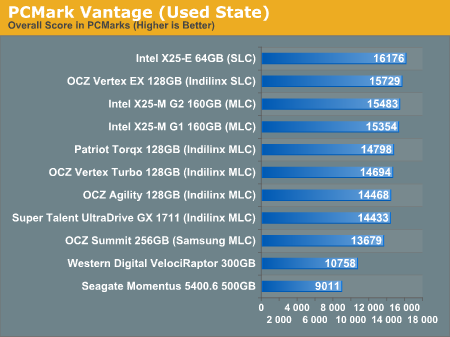
The biggest difference here is that the Samsung based OCZ Summit drops from 5th to 9th place. All of the drives get slower but the Indilinx drives hardly show it. When it comes to dealing with write speed, SLC flash does have the advantage and we see the X25-E and Vertex EX rise to the top of the pack. The G2 is slightly faster than the G1 and the Indilinx drives follow in close pursuit.
The mechanical drives don't change in performance since they don't get slower with use, only as they get more full.
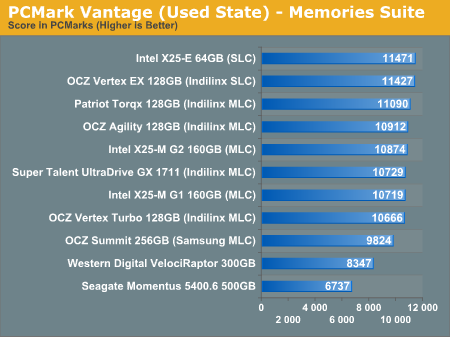
Again we see the two SLC drives at the top, this time followed by a mixture of Indilinx/Intel drives, and the Samsung based Summit is at the bottom of the pack before we get to the HDDs.
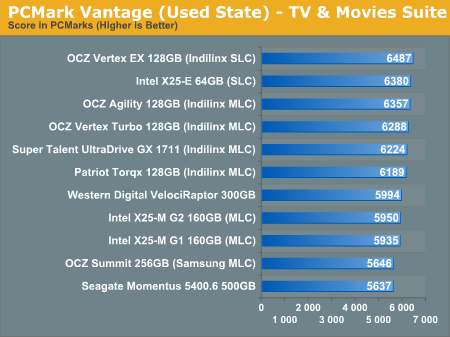
The spread in SSD performance here is only 10% between the slowest non-Samsung drive and the fastest. That tells me that we're mostly CPU bound, but the worst performers other than the Samsung drive are the two Intel X25-Ms. That part tells me that we're at least somewhat bound by sequential write speeds. Either way, the Indilinx drives have a good showing here.
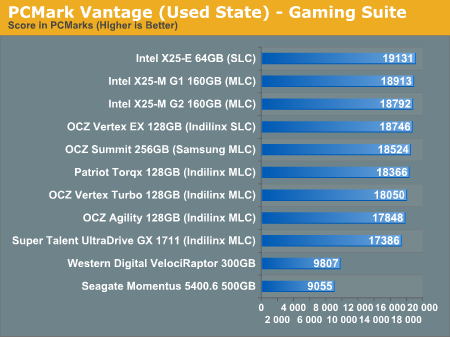
Intel followed by Indilinx SLC with Samsung in league with the MLC Indilinx drives. This is an SSD's dream.

Despite the improvements, the G2 can't touch the much lower write latency of SLC flash here. The Indilinx and Intel G1 drives intermingle while the Samsung drive pulls up the rear. All are faster than a regular hard drive of course.
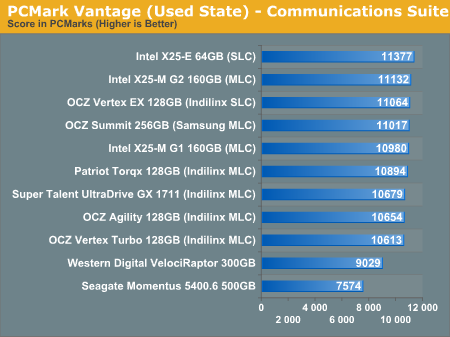

In the multitasking test we once again see Intel rise to the top. The Samsung drive does surprisingly well and the Indilinx drives continue to perform admirably.
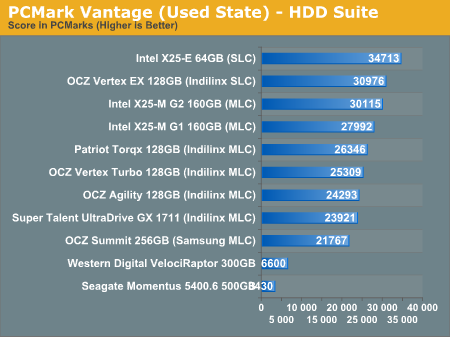
The breakdown between SSDs here is almost linear. The X25-E leads the pack, followed by OCZ's SLC drive. The G2 and G1 are next, then a ton of Indilinx MLC drives. The slowest SSD? The Samsung based Summit of course.










295 Comments
View All Comments
jtleon - Tuesday, September 8, 2009 - link
Yes I fell asleep atleast 3 times reading this article (it IS Monday afterall)Yes, Indilinx clearly rocks the SSD world - Now I know thanks to Anand!
Stories like this set the standard for all review sites - I don't come away with the feeling I was just sold a bill of goods by some schiester in Intel's pocket, or otherwise.
Great Job Anand! Keep them coming!
SSDdaydreamer - Tuesday, September 8, 2009 - link
I too am wondering whether TRIM will be available on the Intel Drives for Windows XP or Vista. I seriously doubt it, as the OCZ Wiper Tool appears to only be available for Indilinx controllers. Perhaps Intel will introduce their own wiper utility. I am leaning towards the OCZ Vertex or Patriot Torqx drives, as I am quite content with Windows XP and Windows Vista.I have an itchy trigger finger on these SSDs, but I want to hold back for the following unknowns.
1. I would like to use the NTFS file system for my drive, but I am unsure of the proper/ideal block size.
2. I would merely like to image my existing Windows Installation, but I am worried that performance or stability problems will arise from the NTFS file system. A fresh install could be in order, but it is preferred to image.
3. Is there a way to change the size of the spare area? Maybe I have the wrong idea (perhaps only format part of the drive, unformatted space goes appends to the spare area?) I am willing to sacrifice some of the usable partition space for an increased spare area for improved performance.
4. Are there complications with multiple partitions? If there are multiple partitions on the drive (for multi-boot) do they all share the same spare area? Is it possible to allow their own respective spare areas?
Is there anybody out there that could enlighten me? I'm sure others would do well to have the answers as well. If I make any discoveries, I will be sure to post them.
Thanks in advance.
bradhs - Monday, September 7, 2009 - link
IS there a "Wiper" app for Intel X-25m G2 drives? For people who don't have Windows 7 (TRIM) and want to keep the Intel X-25m G2 running smooth.smjohns - Tuesday, September 8, 2009 - link
No there is no wiper tool for Intel drives at the mo. In addition to this the current firmware on the Intel drives do not have TRIM enabled. I guess this will be released soon after Windows7 is released. I think I have read somewhere that Intel are working on a TRIM version of it's Matrix Storage Manager software that will provide this functionality to the other operating systems.Burny - Monday, September 7, 2009 - link
As many before me: great article! I learned a lot about SSD's. Even up to the point i'm ready to buy one.I still have 2 questions tough:
2. Will TRIM be available on the G2 Intel drives for sure? Some sources doubt this: http://www.microsoft.com/communities/newsgroups/en...">http://www.microsoft.com/communities/ne...t=&l...
3. As I understand, TRIM will work on a firmware level. That implies that TRIM will also function under Windows XP or any OS for that matter? Then why the need to build another TRIM into Windows 7? Or does a TRIM firmware enabled SSD simply allows the OS to use TRIM?
Thanks!
smegforbrain - Monday, September 7, 2009 - link
While I consider myself handy with computers, I'm not the best technical mind when it comes to the details. You do an excellent job of presenting everything in a manner that it can be understood with little difficulty. I look forward to future articles about SSDs.I do have a question I'm hoping somebody can answer. I'm as interested in the long-term storage outlook of SSD drives as I am every day use. I've seen it said that an SSD drive should hold its charge for 10 years if not used, and it was discussed a bit earlier in this thread.
Yet, none of my current mechanical hard drives are more than 3 years old; none of my burned DVDs/CDs are older than 5 years. It seems far more likely that I would replace an SSD for one with a greater storage capacity after 5 years tops than to expect one to be in use, even as archival storage, for as long as 10 years.
So, is the 10 year 'lifespan' even going to be an issue with archival storage for most people?
Will this worry over the life span of an SSD become even less of an issue as the technology matures over the next couple of years?
Starcub - Tuesday, September 8, 2009 - link
"So, is the 10 year 'lifespan' even going to be an issue with archival storage for most people?"No, but who takes wads of money out of their wallet to store it on their shelf?
smegforbrain - Tuesday, September 8, 2009 - link
"No, but who takes wads of money out of their wallet to store it on their shelf?"That is simply assuming that they will remain as expensive as they are now. They won't.
BlackSphinx - Sunday, September 6, 2009 - link
Hello! I'm taking the time to comment on this article, because I am very thankful for all of these awesome write-ups on SSD.I'm in the process of building an heavily overclocked i7 rig for gaming and video edition, and I was going to jam 2 Velociraptors in Raid0 in there. Why? I had only heard bad things about SSDs in the past.
Reading your aticles, who are, while in depth, very clear and easy to understand, I understand much better what happened in early SSDs, what's so good about recent Indilinx and Intel SSD, and, truly, why I should forgo mechanical drives and instead go the SSD route (which, frankly, isn't more costly than a Raid0 raptor setup). In short, these articles are a great service to the end users just like myself, and if they were intended as such, you have passed with flying colors. Congratulations and thanks.
Transisto - Sunday, September 6, 2009 - link
Could someone reset my brain as to why there is no way to get a (very noticeable) improvement from USB thumb-drives. I mean these thing also get 0.1 ms latency.It's a bit extreme but for the same price I could get 9 cheap 8gb SLC usb drive for around 20$ each and put them in three separate PCI-USB add-on card (5$)
They would saturate the USB controler with 3 drive in it so I Could get around 140mb/s read and 60mb/s write.
Say you manage to merge that into a raid or ... ? Is eboost or Readyboost any good at scaling up ?